| Andrés Carrasco - 65 years old. Argentine government scientist and co-author of the new report, GM Soy: Sustainable? Responsible? Research published in August 2010 by Professor Carrasco found that glyphosate causes malformations in frog and chicken embryos at doses far lower than those used in agricultural spraying. Carrasco is director of the Laboratory of Molecular Embryology, University of Buenos Aires Medical School and lead researcher of the National Council of Scientific and Technical Research (CONICET), Argentina. |

|
| Angel Strapazzon (second from right) – 60 years old. From Quimilí, Santiago del Estero, Argentina. Community educator. A member of the peasant movement of Santiago del Estero – Movimiento Campesino de Santiago del Estero or MOCASE-VÃa Campesina. The boy second from left wears a T-shirt with a slogan that has become a rallying cry for those opposing the GM soy farming model: "Soy today, hunger tomorrow". |
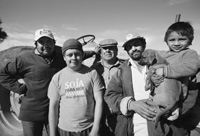
|
| Dario Gianfelici - 57 years old. Rural physician from Cerrito, Argentina. He was one of the first medical doctors to report the effects of agrochemicals on health. |
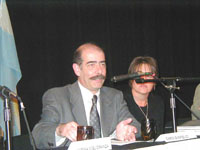
|
| Viviana Peralta - a 42-year-old mother of six from San Jorge, Santa Fe, Argentina. Peralta had to rush her newborn baby daughter, Ailen, to a hospital after agrochemicals were sprayed on GM soy from planes flying near her home. The baby had turned blue and Peralta herself was suffering respiratory problems. After the incident, Peralta joined with other residents to launch a lawsuit against soy producers that resulted in a landmark court ruling banning the spraying of glyphosate and other agrochemicals within 1500 yards of houses. |
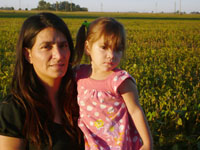
|
| Viviana Peralta and family |
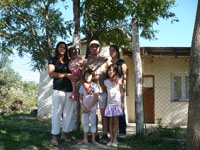 |
| Baby with hydrocephalus or water on the brain, a common effect of agrochemicals exposure – Photo by Jorge Galeano, Region: Caaguazu, Paraguay. Nearly all soy in that region is GM Roundup Ready soy. |
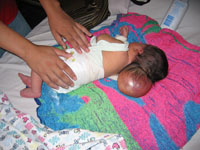 |
| Baby with sores from agrochemicals spraying in a GM soy-producing region of Paraguay – Photo by Jorge Galeano. Community of Mbokaya'i (Vaqueria). Region: Caaguazú, Paraguay |
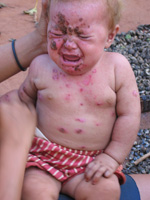 |
| An open box of RoundUp herbicide in an open air trash dump area. |
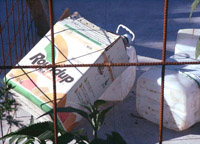 |
| Aerial spraying of glyphosate on GM soy, Argentina. Aerial spraying increases problems of drift. |
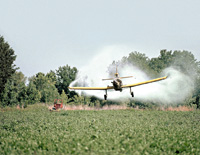 |
| Argentine farmers and villagers displaced by soy and chemicals – the sign reads, “No more evictions”, referring to farmer and village families forcibly displaced as a result of massive planting of GM soy and the use of chemical intensive agriculture by large landholders. |
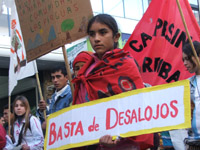 |
|
March MOCASE - MNCI – The banner reads “National Indigenous Peasant Movement of Argentina”. The MOCASE (Peasant Movement of Santiago del Estero)
|
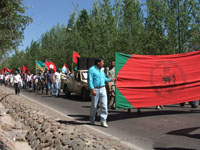 |
| Poster for Silvino Talavera Justice – This poster deals with events associated with the death of 11-year-old Silvino Talavera from agrochemical poisoning in Itapua, Paraguay, on 7 January 2003. The Talavera Villasboa family live surrounded by monocultures of Monsanto's GM Roundup Ready soy. The aggressive marketing and rapid expansion of GM Roundup Ready soy has been the cause of the exponential increase in glyphosate spraying over the Paraguayan countryside and its people. In 2003, Silvino Talavera was sprayed with an agrotoxic cocktail used to fumigate "RoundUp Ready" soy fields. The spraying also contaminated the food that Silvino was carrying, which consequently led to the poisoning of 22 members of his family. In addition to Silvino, his sisters Sofia (13) and Patricia (2), had to be hospitalized during the following days. Silvino was both sprayed and then food-poisoned when he ate the contaminated food. He didn't survive this double attack and died a few days later. Glysophate was one of three agrochemicals found in his blood. The whole family group is at present suffering from ever worsening health due to the indiscriminate use of agrotoxins in the region. The family has come under heavy pressure to drop the court case, including death threats. The court case is in danger of being dropped, and the crime going unpunished by the law. The case has been static in court in an ongoing appeal process for over a year, according to a website chronicle. |
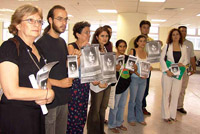 |
| A representative of the activist group Mothers from Ituzaingo, Cordoba, Argentina, showing a map with all the cases of sick people in their neighbourhood, linked with agrochemicals spraying, marked on them. |
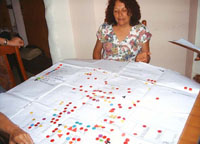 |












